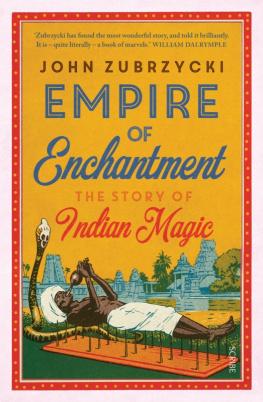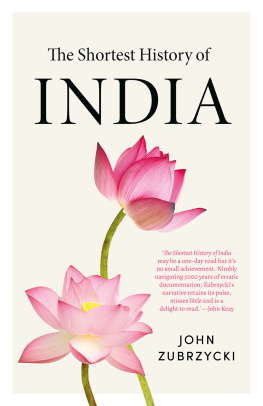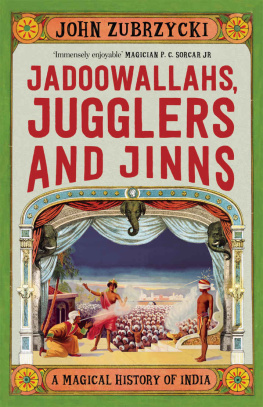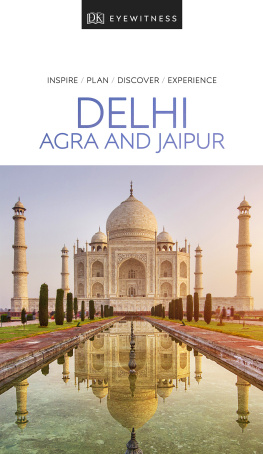John Zubrzycki - The House of Jaipur: The Inside Story of Indias Most Glamorous Royal Family
Here you can read online John Zubrzycki - The House of Jaipur: The Inside Story of Indias Most Glamorous Royal Family full text of the book (entire story) in english for free. Download pdf and epub, get meaning, cover and reviews about this ebook. year: 2021, publisher: C. Hurst & Co., genre: Detective and thriller. Description of the work, (preface) as well as reviews are available. Best literature library LitArk.com created for fans of good reading and offers a wide selection of genres:
Romance novel
Science fiction
Adventure
Detective
Science
History
Home and family
Prose
Art
Politics
Computer
Non-fiction
Religion
Business
Children
Humor
Choose a favorite category and find really read worthwhile books. Enjoy immersion in the world of imagination, feel the emotions of the characters or learn something new for yourself, make an fascinating discovery.
- Book:The House of Jaipur: The Inside Story of Indias Most Glamorous Royal Family
- Author:
- Publisher:C. Hurst & Co.
- Genre:
- Year:2021
- Rating:3 / 5
- Favourites:Add to favourites
- Your mark:
- 60
- 1
- 2
- 3
- 4
- 5
The House of Jaipur: The Inside Story of Indias Most Glamorous Royal Family: summary, description and annotation
We offer to read an annotation, description, summary or preface (depends on what the author of the book "The House of Jaipur: The Inside Story of Indias Most Glamorous Royal Family" wrote himself). If you haven't found the necessary information about the book — write in the comments, we will try to find it.
The House of Jaipur: The Inside Story of Indias Most Glamorous Royal Family — read online for free the complete book (whole text) full work
Below is the text of the book, divided by pages. System saving the place of the last page read, allows you to conveniently read the book "The House of Jaipur: The Inside Story of Indias Most Glamorous Royal Family" online for free, without having to search again every time where you left off. Put a bookmark, and you can go to the page where you finished reading at any time.
Font size:
Interval:
Bookmark:

The House of Jaipur
The Inside Story of Indias Most Glamorous Royal Family

First published by Juggernaut Books 2020
Published in the United Kingdom in 2021 by
C. Hurst & Co. (Publishers) Ltd.,
83 Torbay Road, London NW6 7DT
John Zubrzycki, 2021
All rights reserved.
Printed in the United Kingdom
The right of John Zubrzycki to be identified as the author of this publication is asserted by him in accordance with the Copyright, Designs and Patents Act, 1988.
A Cataloguing-in-Publication data record for this book is available from the British Library.
ISBN: 9781787385566
This book is printed using paper from registered sustainable and managed sources.
www.hurstpublishers.com
To my late mother, Aleksandra Zubrzycka
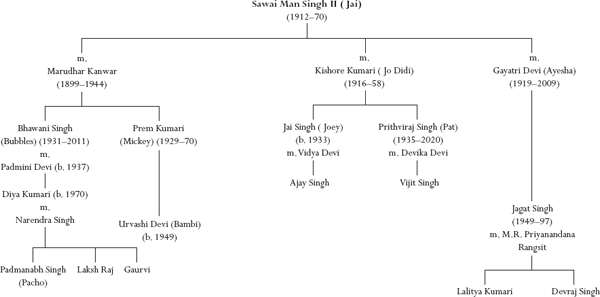
Every year on the full moon night of Sharad Purnima, the harvest festival that coincides with the end of the monsoon, Gayatri Devi would hold a party on the rooftop terrace of her residence, Lily Pool. In Hindu tradition the festival commemorates Krishnas amorous dance of divine love with the female goatherds, or gopis. To reflect the light of the moonbeams, idols of the god are adorned with silver and dressed in white silk. Bowls of a heavenly rice pudding, kheer, absorb the moons cosmic rays and are distributed as prasad, a food offered to the gods, the following morning. When Gayatri Devi celebrated the festival, there were no electric lights, just the glow of the celestial body. The table service was silver but the dress code and decorations were strictly pale pinkas was the colour of her city. She was, after all, the Queen of Jaipur.
There have been no parties here for well over a decade. Lily Pools art deco facade is showing its age. Plaster used to repair the walls has cracked and mould from the monsoon rains has stained the paintwork. Lily Pool was once part of the sprawling Rambagh Palace complex, the home of Gayatri Devi and her husband, Sawai Man Singh II, the Maharaja of Jaipur, before it was turned into a five-star hotel.
For years, the only boundary separating Rambagh from Lily Pool was a fringe of bushes and tall ashoka trees. Now a wire fence and a locked gate bar access to the hotel. The locks were put on by the hotel staff in the days after Gayatri Devis death in July 2009, ostensibly over non-payment of rent. Overnight a brick wall came up, sealing off access to the swimming poolanother symbol of the litigation that sullies the otherwise idyllic surroundings. Across the road from Lily Pool, grounds that once housed horse stables have been turned into a mothballed sports facility, part of a land acquisition drive by the Jaipur Development Authority (JDA). Guests once described Lily Pool as heaven on earth. In the gathering darkness it feels more like an entombed reliquary of distant dreams and arrested glamour.
I am meeting Ayub Khan, whose father once worked at the Rambagh Palace. Khan used to earn a few rupees a day as Gayatri Devis ballboy on Lily Pools now abandoned tennis courts. After he completed his college degree, she offered him a job as a typist and bought him a trusty Godrej manual typewriter. It was a trajectory that ultimately saw him become her principal private secretary and a close confidant, often accompanying his employer on her annual visits to Britain. For three decades Khan typed all her correspondenceresponses to constituents seeking help for their daughters dowries, invitations to heads of state to visit her in the Indian winter, complaints to politicians who were neglecting Jaipurs heritage. Every year she would send Prince Philip a box of Alphonso mangoes for his birthday, recalls Khan, who regularly met the British royal at polo matches in England. I imagine Khans humbleness appealed to Gayatri Devi, who championed those she liked but could be ruthless towards those she didnt.
It is only a decade since Gayatri Devi died, but such was her stature it could have been a few weeks ago. Her memory is revered, her portrait found in many Jaipur homesthough strangely enough not in the City Palace Museum. She was the woman who took on Indira Gandhi, winning three straight elections despite neither speaking nor understanding the language of her constituents, then paid for her success with a lengthy incarceration in Delhis notorious Tihar Jail. Her ghost-written memoir, A Princess Remembers, is still a bestseller, though as a historian I found it more valuable as a resource for what she omitted than what she left in. Life and Vogue magazines ranked Gayatri Devi with her doe-like eyes, flawless complexion and jetblack hair that fell on her shoulders in perfectly cascading waves, one of the worlds most beautiful womena dream in sari and jewels.
Gayatri Devi and Man Singh, or Ayesha and Jai as they were known to their friendsare central to the story of Jaipur over the past century. But the predominantly hagiographic accounts of their lives mask a complex, often tragic and sometimes dark tapestry. Despite being brought up in Cooch Behar, in Bengal, one of Indias most progressive princely states where polygamy was frowned upon, Ayesha agreed to be the Maharajas third wife, knowing she would have to surrender to the norms of the ultraconservative warrior ethos of Hindu Rajput society. Jai was also an ambiguous character. His duties as a ruler often came a distant second to indulging in the distractions that Western society had to offerpolo, parties and beautiful women. The British accused him of doing too little for the people of his state. Following Independence, stripped of all his powers as a ruler by the Indian government, it became almost impossible for him to do anything meaningful for those very same people.
Today, Jaipur is synonymous with the romance and valour of princely India. The citys romanticized mythology owes much to its First Family. Jai set the sporting world ablaze as captain of the most successful polo team of its day. In the 1950s and 1960s, Jai and Ayesha were Indias golden couple, its answer to John and Jackie Kennedy, Queen Elizabeth and Prince Philip. They were the only Indians invited to Truman Capotes Black & White Ball in 1966 at New Yorks Plaza Hoteland Ayesha was the only woman who was allowed to break the dress code, arriving in a gold sari and a necklace of emeralds. Frank Sinatra, Rose Kennedy and the Duke and Duchess of Windsor were there too. All were friends of the Jaipurs.
Handsome, personable, athletic and urbane, Jai was the quintessential modern-day maharaja, with a portfolio of gleaming palaces bursting with taxidermied tigers and sporting trophies, garages full of collectible cars and stables full of polo ponies and caparisoned elephants. Ayesha, like her mother, Indira Devi of Cooch Behar, was unique among Indian maharanis, breaking the stereotype of Indian princesses demurely hidden behind their veils. Born into a small eastern princedom, she grew to be a woman who was an international social celebrity, in a class apart from the maharanis of bigger, twenty-one-gun-salute princely states such as Gwalior or Kashmir. She combined the exotic allure of the East with the sophistication of Western aristocracy. Schooled in England and Switzerland, she spoke French better than she spoke Hindi, danced with the grace of a professional and rode horses as if she had been bred for the sport. She wore her trademark chiffon saris with the same stylish elan as she wore trousers, while sipping cocktails and smoking her fashionably long cigarettes. As a couple, Jai and Ayesha entertained their Western friends as royally and lavishly in London, New York and Paris as in their magnificent palaces, forts and hunting lodges in Rajasthan. In the hierarchy of Indias princely states, Jaipur was not the most important, but it was the most evocative, the most romantic, the most glamorous. Everyone who can possibly contrive it goes to Jaipur. There is no other place quite like it, wrote Rosita Forbes in the 1930s.
Font size:
Interval:
Bookmark:
Similar books «The House of Jaipur: The Inside Story of Indias Most Glamorous Royal Family»
Look at similar books to The House of Jaipur: The Inside Story of Indias Most Glamorous Royal Family. We have selected literature similar in name and meaning in the hope of providing readers with more options to find new, interesting, not yet read works.
Discussion, reviews of the book The House of Jaipur: The Inside Story of Indias Most Glamorous Royal Family and just readers' own opinions. Leave your comments, write what you think about the work, its meaning or the main characters. Specify what exactly you liked and what you didn't like, and why you think so.


